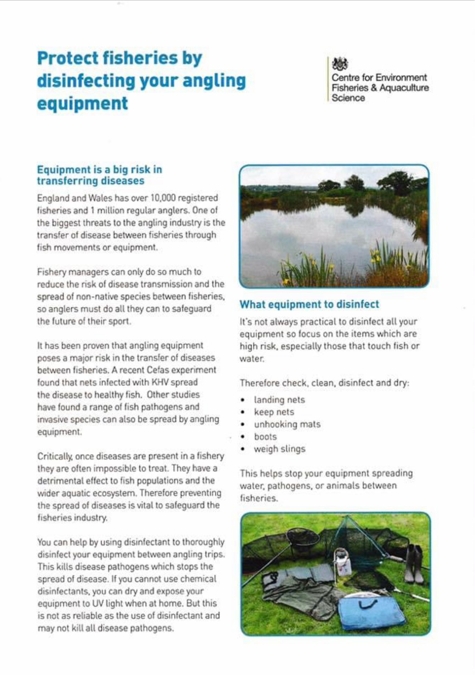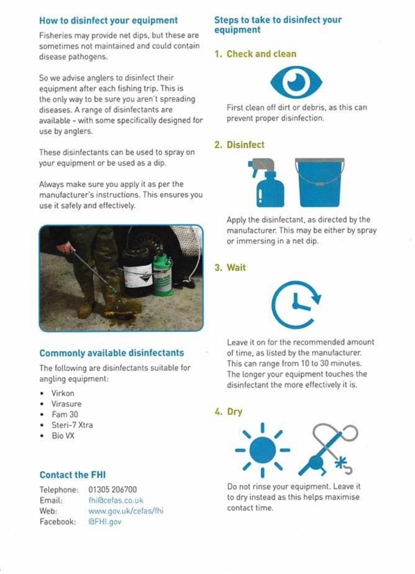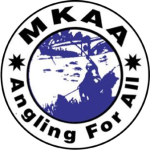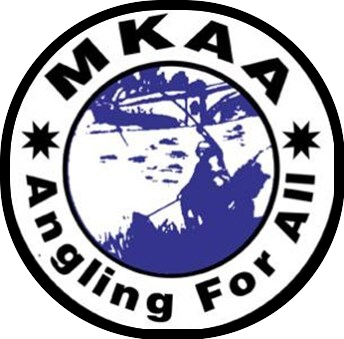The Anglers Code of Conduct
SAFETY
General Safety
When long casting, watch out for people on the far bank in case the line breaks. Always use an adequate breaking-strain line when using heavy weights. Shock leaders are recommended for heavyweight distance casting. Always ensure that they are securely attached to the main line and that they are safe, so that any lead can fall free of the rig should a breakage occur. Be aware of the dangers of wading and never wade where you are not sure it is safe or allowed to do so. On rivers, beware of undercut banks and rising water levels. Never fish within 30 metres of any electric power lines. Never forget you can be electrocuted even if your rod or pole does not actually touch a power line-watch out! Look out for warning signs, Always notify someone of where you intend to fish and what time you are expected to return. In pulling for a break to free a snagged line, be aware leads/tackle, (even a float) can fly back and cause serious injury. Apply leverage sideways away from you, or at least turn away from the direction of pull to safeguard your eyes; thick clothing may also help avoid injury. When fishing from very steep, slippery river-banks it is sensible to use a length of rope tied to a tree or post for assistance. You may also wish to consider wearing a lightweight buoyancy aid. Never walk out onto frozen waters. The ice is usually too thin to support a person’s weight. Falling in can lead to lives being lost, both yours and those of any rescuers. Take care when moving about at night. We suggest carrying a whistle in order to attract attention in an emergency.
Anglers should be aware of the dangers of Weil’s Disease
Weil’s Disease is transmitted through rats’ urine on the bankside and at the water’s edge. Cover any open cuts, however small, with waterproof dressings. Food must not be put on the ground and hands must be as clean as possible when eating and preparing food. Never put wet line in your mouth or trim knots with your teeth. Most cases start with an influenza-like illness, which resolves in two to three weeks. Common features are sudden onset of fever, intense headache, severe pains in calf and back muscles, red eyes and prostration. Some cases develop abdominal pains with diarrhoea and vomiting or meningitis. If these symptoms occur, consult a doctor immediately. In the case of severe rat infestation, it should be reported to the water owner. If waters are publicly owned, report to the Pest Control Services division of the Environmental Health Services at your local borough or district council. Take all litter home, As litter attracts vermin.
ETIQUETTE
Conduct At The Waterside
Always park your vehicle considerately and safely, especially on farmland. Close gates behind you, Show consideration to others, anglers and water users. It is good angling practice to minimise bankside noise and movement, and to avoid fishing in a way which interferes with other water users. When setting up bite alarms, it is generally good manners to turn the volume to the minimum mark and/or place your thumb over the speaker. Always consider the peace and quiet enjoyed by residents on or close to fisheries at all times, but especially at night. Banksticks, umbrella poles and other accessories should not be knocked in with a hammer or other implement. If the ground is very hard, use threaded poles, banksticks, pegs etc. Do not use bright lights at night; use a shaded torch. avoid shining any lights directly at other anglers or water users. Before joining other anglers for a social chat, consider that this is not always welcome. If you do so, remove your bait from the water. Also, do not use any equipment such as mobile phones, radios or TVs which are audible to others. Do not shout or use bad language. Avoid casting into other anglers swims or water, or distance casting that stops other anglers from fishing areas of a water normally accessible from their swim. If using two or more rods (subject to Agency byelaws and local club rules), remember that rod butts must not be further apart than a maximum spread of three metres. Be aware of any specific rules relating to the fishery – and observe them. Under no circumstances leave any litter on the bankside.
FISH HANDLING / CARE
Essential Equipment that should allways be carried and used,Knotless landing net, big enough for the intended species.(For pike ) special wide mesh nets may be used to minimise tangling with treble hooks.) Dual mesh nets also help. The top wide mesh reduces water drag when the net is raised, and the close mesh or sacking base enfolds the fish while ensuring no damage is done to the fins or the scales.
Disgorger and forceps.
Quality unhooking mat suitable for large fish.
Weigh sling or bag in good condition.
Anti-bacterial solutions suitable for fish.
HANDLING
Always use an unhooking mat big enough for the intended species, spread on a soft flat surface, rather than on uneven or hard bankside. Be aware that watch straps, Buttons, Zips, lapel badges and jewellery could catch and damage your capture. Do all you can to minimise the time your capture is out of water, handle it as little as possible. Covering its head with a wet cloth or piece of wet netting will help keep it calm and stop it flapping. Deep-hooked fish should survive if the hook cannot be removed. Cut the line as far into the mouth as possible. Do not pull hard on the line and always release the fish as soon as possible. When releasing a fish, support it carefully in the water, facing upstream (if in a river), until it is ready to swim off naturally. Barbel and may have a particularly long recovery time, and should be supported in the water or held in a landing net until they are fully recovered. Respect all fish no matter the size or species.
All eels should be returned alive, as it takes a long time for them to reach specimen size. Eels may become land-locked, in which case they will grow to specimen proportions and provide anglers with an interesting target. Once on the bank all eels should be handled with care. It is particularly important that the protective mucus is not removed in handling; never use newspaper to hold them but lay them on their backs and gently hold in this position for a few moments. The eel will calm down and is unlikely to move from this position. Unhook with forceps, if the eel is hooked in the lips or scissors. If the eel is deep hooked cut the line or trace as close to the eel’s lips as possible and release immediately. The eel, under these circumstances, will lose the hook very quickly. Do not attempt to remove deep hooks from eels. The heart and other vital organs are very close to the back of the throat and you may cause fatal injuries if you damage them. Deep hooked perch should be treated with the same care as you would with eels. Hooklengths or traces should be cut as low down as possible and under no circumstances try to use a long disgorger to remove deep hooks. In perch, the heart is very close to the back of the throat and it has been shown that fish are much more likely to survive if left to shed the hook naturally. Never drop or throw fish back into the water. Sacks, slings, mats, nets and your own hands must all be wetted before use; note a mat left in the sun should be dipped in the water to cool it first. Transfer fish back to the water in a sling or enclosed mat, never carry them. Dry ALL Sacks, slings, mats, nets in direct sunlight after use to prevent any spread of desease.
PHOTOGRAPHY
Also see previous section under Handling. Select location for photography prior to commencing fishing, the position of the unhooking mat plus wet covering etc, and have camera ready loaded with sufficient film / batteries ect, before bringing the fish onto the bank. When holding a fish, support it properly and keep it close to the ground, over a wet unhooking mat. Never stand, as dropping a fish could cause it severe damage. The photography of eels will be considerably easier if done immediately after the unhooking technique outlined under Handling above.
SACKS AND TUBES
Use only when necessary, and retain fish for the minimum time possible. Large fish that have been retained for a prolonged period can be difficult to handle, so be prepared. Check the fish as often as possible. These sort of accessories should be of a reputable make, with plenty of holes to provide a good water exchange. Ensure that they are clean and in good condition, and check the water flow through them, otherwise fish could be damaged. In use, secure in deep water only, even at night. In shallow margins fish may suffer or even die due to extremes of temperature or lack of oxygen. Stake out securely, placing only one fish in each sack or tube. Secure the sack or tube with a bouy or float. In rivers, ensure that the fish faces upstream. Release fish immediately if they show signs of distress. Hold them upright in the water (facing upstream in rivers), until they push off hard of their own accord. For catfish, zander, perch, big bream and barbel – only tubes should be used, and they must be large enough to properly accommodate the fish. Big bream however, can also be kept safely in large keepnets with 28″ diameter rings. Please note that it is also helpful to cover a staked-out keepnet with light, damp sacking or weed. Framed sacks are also suitable. The health, care and welfare of the fish must always be your first priority.
KEEPNETS
Keepnets are only suitable for small shoal fish. Never use for large carp, pike, tench, perch, barbel, or catfish. Large fish are not suited to keepnets because of their size, and others, regardless of size, such as carp and barbel, are unsuited because the serrated front rays of their dorsal fins can be caught and damaged by the netting. Use only when necessary, and retain fish for the shortest time possible. Locate as said earlier with sacks and tubes. A “stake out bar” to prevent the net from collapsing ,or a weight on the end of the net is helpful, when wind or current could move it to the detriment of the fish. In moving water, a rectangular section net helps avoid rolling. Keepnets must comply with Agency and club byelaws. Those with a drawstring or zip bottom release are best. The use of keepnets incorporating ‘The carp sack’ at the bottom to provide a dark, safe area, is to be encouraged. These are often referred to as ‘conservation mesh’
KEEPNET CODE
Wet hands before holding any fish. Place the fish in the keepnet gently and as quickly as possible. Once the keepnet is positioned, avoid all unnecessary disturbance. Retain fish in keepnet for the minimum period of time. Always use the largest keepnet possible. Do not overcrowd a keepnet – when big catches are expected, take two nets. Also When safe to do so, (on still or shallow waters) always peg out the keepnet to prevent collapse. When returning the fish to the water or weighing in: Always place the keepnet as near to the fishing position as you can and Collapse the keepnet and place the fish gently in the weigh sling or water – preferably immediately and in front of you, so fish, bag, or back into the water. can be done quickly. Do not slide or tumble fish down the keepnet.
EA BYELAWS
On Keepnets, keepsacks and landing nets.
Any person shall be guilty of an offence if he uses:- A landing net with any knotted meshes or meshes of metallic material. A keepnet with any knotted meshes or meshes of metallic material, or having any holes in the mesh larger than 25mm internal circumference, or of less than 2.0 metres in length, or with supporting rings or frames greater than 40cm apart (excluding the distance from the top frame to the first supporting ring or frame) or less than 120cm in circumference. A keepsack not constructed of a soft, dark coloured, non-abrasive, water permeable fabric, or having dimensions of less than 120cm by 90cm if rectangular, or 150cm by 30cm by 40cm if used with a frame or designed with the intention that a frame be used. Any person shall be guilty of an offence if he retains more than one fish in a single keepsack at any time. This Byelaw shall not apply to any keepnet or keepsack used for retaining eels which have been legally taken by instruments other than rod and line. This byelaw was made taking account of the requirement for notification to the European Commission under Council Directive 83/189/EEC.
Prevention of the spread of Koi Herpesvirus Disease.



